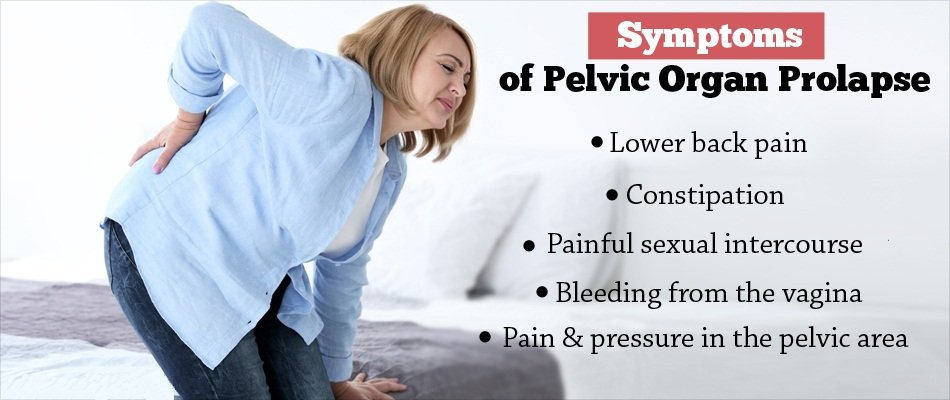Pelvic organ prolapse is the point at which at least one of the organs in the pelvis descend their ordinary position and lump into the vagina.
It can be the womb (uterus), gut, bladder or best of the vagina.
A prolapse isn't hazardous, yet it can cause agony and distress. Manifestations can as a rule be enhanced with pelvic floor activities and way of life changes, however once in a while therapeutic treatment is required.
Indications of pelvic organ prolapse
Pelvic organ prolapse indications include:
a sentiment of weight around your lower stomach and privates (pelvis)
a hauling uneasiness inside your vagina
having an inclination that there is something descending into your vagina – it might have a craving for sitting on a little ball
feeling or seeing a lump or irregularity in or leaving your vagina
uneasiness or deadness amid sex
issues peeing –, for example, feeling like your bladder isn't discharging completely, expecting to go to the latrine all the more frequently, or releasing a little measure of pee when you hack, sniffle or exercise (stretch incontinence)
Now and then pelvic organ prolapse has no manifestations and is found amid an interior examination completed for another reason, for example, cervical screening.
At the point when to see your GP
See your GP on the off chance that you have any of the side effects of a prolapse, or on the off chance that you see a protuberance in or around your vagina.
What occurs at your arrangement
Your specialist will inquire as to whether they can complete an inside pelvic examination.
For this you should disrobe starting from the waist and lie back on the examination bed. Your specialist will then feel for any bumps in your pelvic region and inside your vagina. They may tenderly put an instrument called a speculum into your vagina to hold its dividers open so they can check whether there is a prolapse.
Here and there they will request that you lie on your left-hand side and look at you in that situation to improve perspective of the prolapse.
A few ladies may put off setting off to their GP on the off chance that they're humiliated or stressed over what the specialist may discover. In any case, the examination is imperative. It just takes a couple of minutes and is like having a spread test.
You can request this examination to be finished by a female specialist and, on the off chance that you like, carry somebody you trust alongside you for help.
Additionally tests
In the event that you have issues with your bladder, your GP may allude you to doctor's facility for additionally tests. These may include:
a pee test to search for a contamination
embeddings a little tube into your bladder to search for any issues
Treatment for pelvic organ prolapse
On the off chance that you don't have any side effects, or the prolapse is mellow and not irritating you, you may not require medicinal treatment. However, rolling out some way of life improvements will most likely still help.
In the event that the prolapse is more extreme, or your indications are adversely influencing your every day life, there are a few restorative treatment alternatives to consider, including:
way of life changes, for example, ceasing smoking, shedding pounds and pelvic floor works out
hormone treatment
vaginal pessaries
medical procedure
The prescribed treatment will rely upon the sort and seriousness of the prolapse, your side effects and your general wellbeing. You and your specialist will choose together what is the best alternative for you.
Read more about treatment for pelvic organ prolapse.
Reasons for pelvic organ prolapse
Pelvic organ prolapse happens when the gathering of muscles and tissues that regularly bolster the pelvic organs, called the pelvic floor, ends up debilitated and can't hold the organs set up immovably.
Various things can debilitate your pelvic floor and increment your shot of creating pelvic organ prolapse, including:
pregnancy and labor – particularly in the event that you had a long, troublesome birth, or on the off chance that you brought forth a huge infant or various children
moving more seasoned and through the menopause
being overweight or large
having long haul clogging or a long haul condition that makes you hack and strain
having a hysterectomy
an occupation that requires a great deal of truly difficult work
Some wellbeing conditions can likewise make a prolapse more probable, including:
joint hypermobility disorder
Marfan disorder
Ehlers-Danlos disorders
Sorts of prolapse
The 4 principle sorts of prolapse are:
the bladder protruding into the front mass of the vagina (foremost prolapse)
the womb protruding or hanging down into the vagina (uterine prolapse)
the highest point of the vagina (vault) drooping down (vault prolapse) – this happens to a few ladies after they have had medical procedure to expel their womb
the entrail protruding forward into the back mass of the vagina (back divider prolapse)
It's conceivable to have more than one of these in the meantime.
Pelvic organ prolapse will for the most part be grouped on a size of 1 to 4 to demonstrate how extreme it is, with 4 being a serious prolapse.
Wednesday, July 18, 2018
Pelvic organ prolapse
Tags
# Health Care
# More
About Dipoalex
Soratemplates is a blogger resources site is a provider of high quality blogger template with premium looking layout and robust design. The main mission of templatesyard is to provide the best quality blogger templates.
More
Labels:
Health Care,
More
Subscribe to:
Post Comments (Atom)

No comments:
Post a Comment